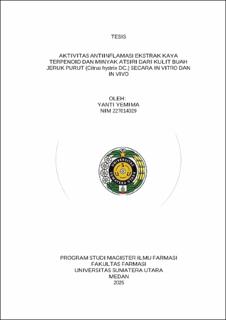| dc.description.abstract | Background: Chronic inflammatory diseases are a global health concern. Inflammation is the body’s initial response to tissue injury, involving the migration of neutrophils and inflammatory mediators to the injured area. NF-κB activation by LPS and carrageenan enhances the production of NO, TNF-α, and IL-6, thereby exacerbating inflammation. Terpenoids from plants, particularly the peel of kaffir lime (Citrus hystrix DC.) from the Rutaceae family, hold potential as alternative anti-inflammatory agents with possibly fewer side effects compared to conventional drugs.
Objective: To evaluate the anti-inflammatory activity of the extract and essential oil from kaffir lime peel through NO inhibition in vitro and the reduction of inflammation, neutrophil counts, TNF-α, and IL-6 expression in vivo.
Methods: The n-hexane extract was prepared using maceration, while essential oil was isolated using the MAE method. The simplicia, essential oil, and their components were characterized and identified using GC-MS. NO inhibition was assessed using the Griess reaction. The in vivo study involved male rats administered kaffir lime peel extract and essential oil at doses of 50, 100, 200, and 400 mg/kgBW, with inflammation induced by carrageenan. Parameters included inflammation percentage, neutrophil counts analyzed with hematoxylin-eosin staining, and TNF-α and IL-6 expression evaluated using immunohistochemistry. Results: Simplicia characterization showed moisture content of 5.9%, water- soluble extract content of 24.21%, ethanol-soluble extract content of 13.19%, total ash content of 4.52%, and acid-insoluble ash content of 1.51%. Essential oil characterization included a specific gravity of 0.838 ± 0.0118 g/mL and a refractive index of 1.472 ± 0.0001. GC-MS analysis confirmed the presence of terpenoids. The extract and essential oil at concentrations of 1.56 and 0.78 μg/mL significantly inhibited NO production, achieving 5.66±0.66, 6.10±1.62, 9.58±0.38, and 10.16±0.49 μg/mL compared to the negative control (20.88 μg/mL). The extract’s inhibitory activity at these concentrations was not significantly different from dexamethasone at 0.015 and 0.07 μg/mL. In vivo, the extract and essential oil at doses of 200 and 400 mg/kgBW reduced inflammation percentages, neutrophil counts, and TNF-α and IL-6 expression, comparable to sodium diclofenac at 2.25 mg/kgBW (p>0.05).
Conclusion: The n-hexane extract and essential oil of kaffir lime peel effectively inhibited NO production in vitro and reduced inflammation and inflammatory mediators in vivo, supporting their potential as anti-inflammatory agents. | en_US |


